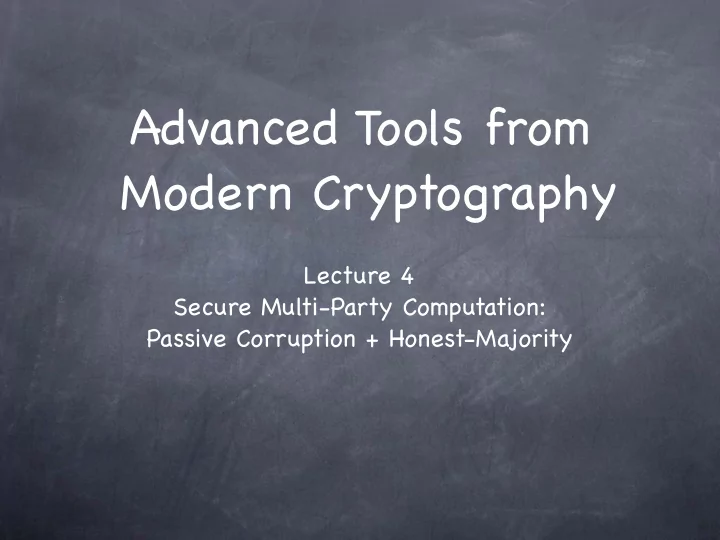

Advanced Tools from Modern Cryptography Lecture 4 Secure Multi-Party Computation: Passive Corruption + Honest-Majority
Must We Trust ? Can we have an auction without an auctioneer?! Declared winning bid should be correct Only the winner and winning bid should be revealed
Using data without sharing? Hospitals which can’ t share their patient records with anyone But want to data-mine on Data combined data Mining Tool
Secure Function Evaluation A general problem To compute a function of private inputs without revealing f (X 1 , X 2 , X 3 , X 4 ) information about the inputs Beyond what is revealed by the X 1 X 4 function X 2 X 3
Poker With No Dealer? Need to ensure Cards are shuffled and dealt correctly Complete secrecy No “cheating” by players, even if they collude No universally trusted dealer
The Ambitious Goal Any task that uses a trusted party! Secure Multi-Party Computation (MPC) Without any trusted party, securely do Distributed Data mining E-commerce Network Games E-voting Secure function evaluation ....
Emulating Trusted Computation Encryption/Authentication allow us to emulate a trusted channel Secure MPC: to emulate a source of trusted computation Trusted means it will not “leak” a party’ s information to others And it will not cheat in the computation A tool for mutually distrusting parties to collaborate
Is it for Real? Getting there! Many implementations/platforms Fairplay, VIFF Sharemind SCAPI Obliv-C JustGarble SPDZ/MASCOT ObliVM … multipartycomputation.com/mpc-software
Is it for Real? And many practical systems using some form of MPC Danish company Partisia with real-life deployments (since 2008) sugar beet auction, electricity auction, spectrum auction, key management A prototype for credit rating, supported by Danish banks A proposal to the Estonian Tax & Customs Board A proposal for Satellite Collision Analysis Legislation in the US to use MPC for applications like a “higher education data system” …
MPC Several dimensions Passive (Semi-Honest) vs. Active corruption Passive: corrupt parties still follow the protocol Honest-Majority vs. Unrestricted corruption Information-theoretic vs. Computational security …
Security Definition Simplest case: Passive corruption, Information-theoretic security Need honest-majority (or similar restriction) In passive corruption, the adversary can see the internals of all the corrupt parties, but cannot control their actions Main concern will be secrecy (correctness is automatic, provided the protocol is corrupt in the absence of corruption) Will ask for Perfect Secrecy Similar to secret-sharing
Security Definition Multiple parties in a protocol could be corrupt Collusion Modelled using a single adversary who corrupts the parties Its view contains all the corrupt parties’ views Security guarantee given against an “adversary structure” Sets of parties that could be corrupt together
Security Definition For secret sharing we needed to formalise “x is secret” Now want to say: x is secret except for f(x) which is revealed ∀ x, x’ s.t. f(x)=f(x’) , { view | input=x} ≡ { view | input=x’ }
Information-Theoretic Passive-Secure MPC Perfectly secure MPC against passive corruption Today: For linear functions Next time: For general functions
MPC for Linear Functions Client-server setting x 1 x 2 x 3 x 4 x 5 Clients with inputs May be same Servers parties Clients with outputs f 1 (x 1 ,…,x 5 ) f 2 (x 1 ,…,x 5 )
MPC for Linear Functions: Using Linear Secret-Sharing x 1 x 2 x 3 x 4 x 5 Clients with inputs Share Servers Linearly Combine Reconstruct Clients with outputs f 1 (x 1 ,…,x 5 ) f 2 (x 1 ,…,x 5 )
MPC for Linear Functions: Using Linear Secret-Sharing x 1 x 2 x v π 21 π 11 σ 11 σ 21 σ v1 Q Q c 11 c 21 c v1 c 12 c 22 c v2 = = : : W : : : : : : c 1,u c 2,u c v,u σ 1n σ 2n σ vn π 2n π 1n Each column with Each column sent Each row given to an input client to an output client a server
MPC for Linear Functions: Using Linear Secret-Sharing View of the adversary (corrupt parties) View of the adversary (corrupt parties) View of the adversary (corrupt parties) x 1 x 2 x v π 21 π 11 σ 11 σ 21 σ v1 Q Q c 11 c 21 c v1 c 12 c 22 c v2 = = : : W : : : : : : c 1,u c 2,u c v,u σ 1n σ 2n σ vn π 2n π 1n Each column with Each column sent Each row given to an input client to an output client a server
Security Adversary allowed to corrupt any set of input and output clients and any subset T of servers s.t. T is not a privileged set (i.e., not in the access structure) for the secret-sharing scheme View of adversary should reveal nothing beyond the inputs and outputs of the corrupted clients Claim: Consider any input y of corrupt clients. If x, x’ of uncorrupted clients such that for each corrupt output client i f i (x,y)=f i (x’,y), then the view of the adversary in the two cases are identically distributed Because for any given view of the adversary, the solution space of randomness has the same dimension in the two cases Exercise
Recommend
More recommend